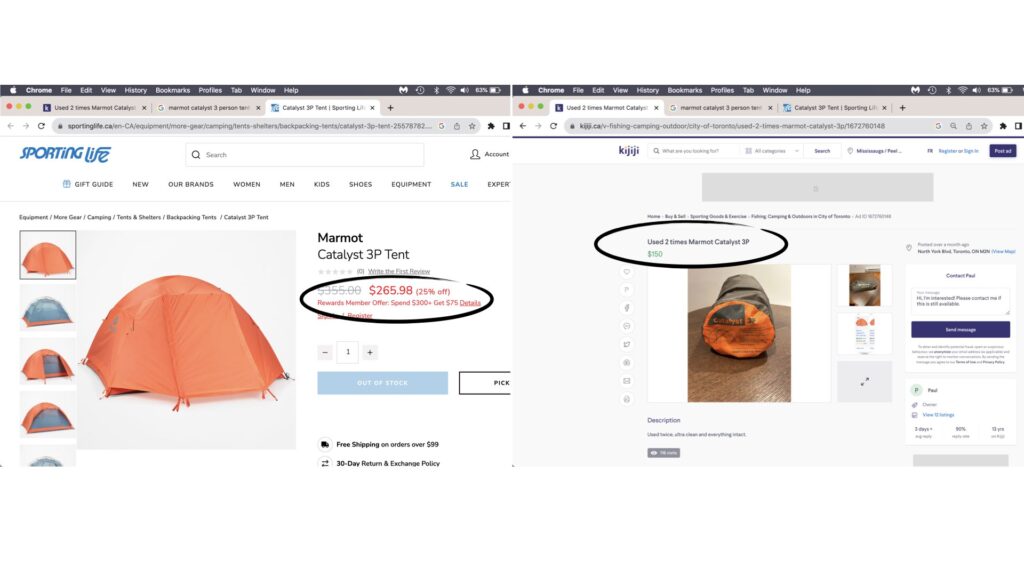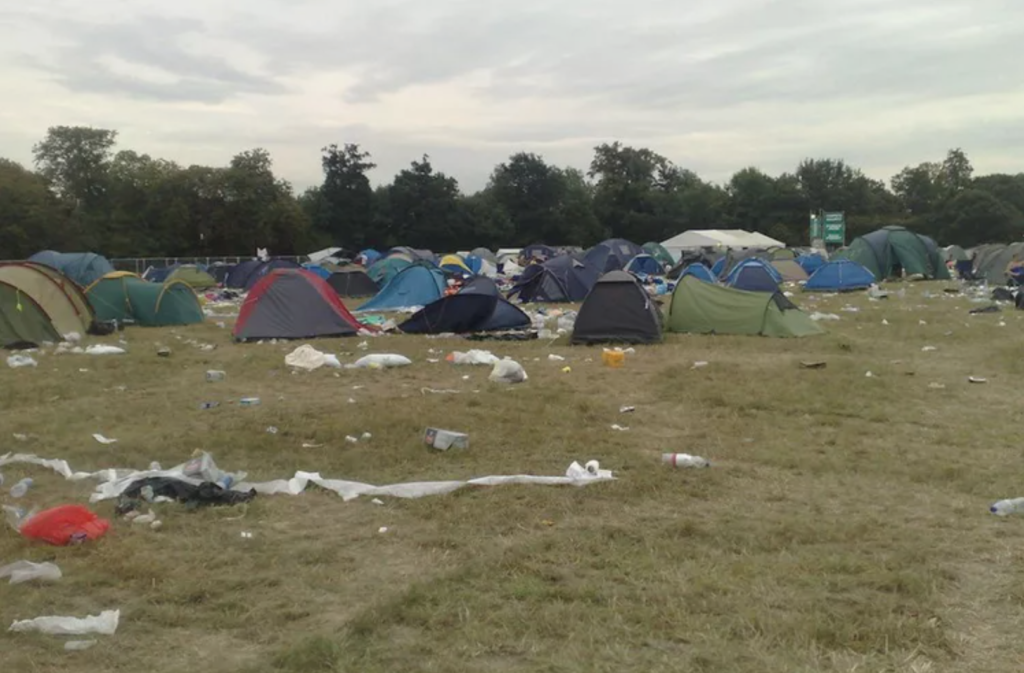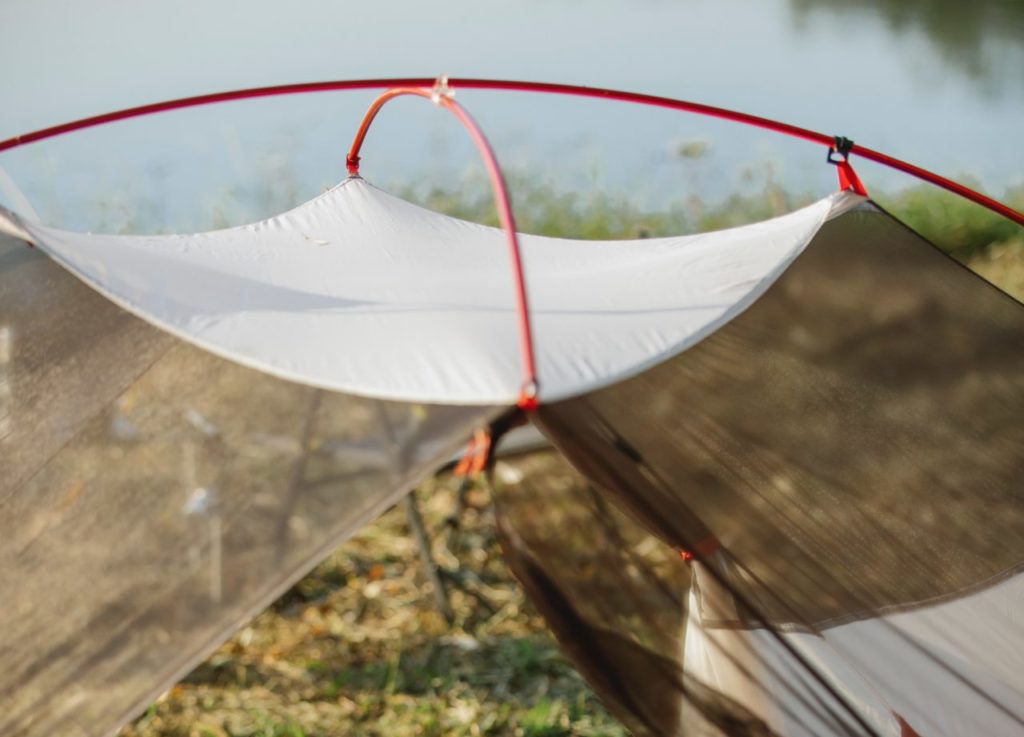Whether it’s from a financial standpoint or an environmental one, buying a used tent might be something you’re considering.
However, before handing over your hard-earned cash, you need to ask yourself is it worth it.
What are the pros and cons, what should you look for, and where should you look when buying a used tent?
Article Contents:
- Pros of Buying a Used Tent
- Cost Savings
- Reduce Environmental Impact
- Cons of Buying a Used Tent
- Potentially Poor Quality
- Repair Costs
- Lack of Warranty
Pros of Buying a Used Tent
1. Cost Savings

If you’re just getting into camping, buying all new gear can start to add up. Well, the first and most obvious benefit of buying a used tent is the cost reduction.
A brand new, high-quality tent can cost hundreds of dollars. According to my database of tent costs, the average cost of a 4-person tent is $403.
Surely it doesn’t come as a surprise that a used tent can cost a fraction of that.
As an example, I found a used Marmot Catalyst 3-person tent on Kijiji for $150. The seller states it’s been used twice. The lowest price I found online for this exact same model new was $265 – $300 including tax in Ontario.
In this instance, you’re saving a whopping 50% of the original purchase price just by buying used! The money you save can be put towards other camping essentials!
2. Reduce Environmental Impact

Another key motivator for buying a used tent is to help reduce your overall environmental impact.
A new tent is made from mostly new materials, which require energy and resources to manufacture, package, and transport. We’re talking about synthetic plastics, like nylon and polyester, for the tent fabric and metal or fiberglass for the tent poles.
These materials aren’t easy to produce. In fact, the impact from a carbon footprint perspective is quite astonishing.
- According to knowcarbon.com, approximately 250,000 tents are thrown away every year by festival goers alone.
- If used only once and thrown-out, the average tent has an equivalent CO2 of 30 kg.
- On an annual basis, those tents in the landfill would be equivalent to 7,500 tonnes of CO2!
What’s interesting is that as the number of repeat uses of a tent increases, the CO2 impact drops substantially.
Comparing a single use tent to one that has 30 days of use, the CO2 impact drops from 35 kg down to 1 kg [Reference].
With this in mind, the next time you’re thinking of getting a new tent, consider renting, borrowing or buying a used tent instead. It’s just better for the environment!
Cons of Buying a Used Tent
1. Potentially Poor Quality

One of the biggest drawbacks when searching for a used tent is sifting through all the poor-quality tents people are trying to pawn off to unsuspecting buyers.
This boils down to two things you should ask yourself:
- If it’s a well-known brand, is the tent so far used that its integrity is now compromised?
- Even if it’s listed as “like-new” condition, is the tent suspect of being a knock-off model?
For the first aspect, the structural and performance integrity of a used tent is critical. Unfortunately, the only way to really test this is to physically interact with the used tent.
- If the tent shows excessive signs of wear and tear, it’s not worth your money.
- Check out 7 Things to Look for When Buying a Used Tent to help guide your search.
For the second aspect, most brand name and reputable tent manufacturers create high-quality goods, which unfortunately are targets for fake knock offs and counterfeits.
- These copy-cat companies produce cheap, low-quality products.
- They might seem good on paper, but won’t stand up to the elevated level of use most of us would come to expect.
My recommendation is to only buy a lightly used tent from a reputable brand name manufacturer, such as Marmot, The North Face, MSR, Big Agnes, Nemo, REI, MEC, Cabela’s or the like.
Tent reviews from these companies are stellar and a used tent would retain much of its integrity.
2. Repair Costs

The next biggest detractor for most people when buying a used tent is the cost to repair it if damage is discovered.
A slightly damaged tent can be advantageous from a cost perspective:
You have better leverage to get a more reasonable price. However, you need to factor in the cost to fix the damage.
Fabric tears and holes, torn mesh, loss of waterproof coating, leaky seams, even bent or broken poles take time, effort and money to fix. If you’re not that handy or would rather have a flawless tent to begin with, buying used isn’t the right option for you.
On the contrary, repairing tent damage isn’t too difficult. If you’re considering doing it yourself, check out How to Repair a Damaged Tent.
- Holes can be repaired with Adhesive Fabric Patches
- Mesh tears can be fixed with Adhesive Mesh Patches
- Waterproofing and UV protection can be restored using a Durable Water Repellant (DWR) Coating Spray
- Broken metal or fiberglass poles can be replaced or repaired with a Tent Pole Splint.
Just remember that all these repair costs add up so make sure you factor that into the price before buying a used tent!
3. Lack of Warranty
Most people seldom think about this, but recently Chetna and I have started to pay closer attention to the product warranty when we purchase new camping equipment.
Every new tent purchased through a retailer normally includes some form of warranty. The standard warranty usually covers manufacturing or material defects for a limited amount of time.
But, as we’ve found out the hard way, outdoor equipment warranties are not all the same. Some companies have rock-solid warranties that cover the product lifetime, whilst others only cover the first year of usage.
Regardless, purchasing a used tent voids the warranty, even if it has never actually been used. That’s because the warranty only covers the original purchaser and oftentimes, requires proof of purchase.
Perhaps the question you need to ask yourself is “is it worth it to buy a used tent and risk not having it covered by any form of warranty”?
This article contains affiliate links, which help support this blog at no cost to you!
